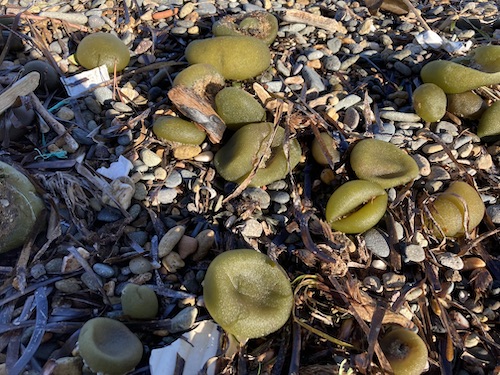(Green Sponge Balls)
There are meatballs, footballs, owl balls, tennis balls, Christmas balls and a lot more balls; but has anyone ever heard of Green Sponge Balls? You could easily hang them on the Christmas Tree – these green spongy algae that linger on the bottom of the sea until a storm sets them into travel mode and then smashes them onto a beach where they slowly die.
Green Christmas Balls
When on land, these green balls, Codium bursa, look like small slowly deflating footballs, whose dented form slowly gets the better of them until they lose their beauty and after fading away between the sand and pebbles they become food for whatever lives there. Certain kinds of dolphins, seals, spider crabs, crocodiles and even black bears devour them as snacks, but their salty taste also can seduce us humans. The totally different looking brother plant, Codium fragile (not a ball, rather a branching seaweed) is known as a delicacy, although its common name Dead man’s fingers does not give you that impression. Mostly found in Asia, this seaweed is pickled and eaten as a salad.
Last week a storm left a huge colony of Dead man’s fingers on the beach, as Christmas presents. When I finally found out what they were, I was too afraid to take them home to include them in some culinary experiments. And because of their deflated form they had also lost their chance of becoming a Christmas Ball.
Juniper
When on Lesvos you dig a little pine tree out of the woods, it is a Herculanian task to decorate it with Christmas Balls, because the branches and needles are very fragile: they would sag even if you were to place a tea bag on a branch. They are not as sturdy as a Christmas fir (a tree that doesn’t grow here on Lesvos). However I was pleasantly surprised to discover some junipers (Juniperus communis). This evergreen shrub which bears big berries that change from green into a deep black-blue appears to be stronger than a Christmas Tree. They belong to the cypress family Cupressaceae and their branches are thickly covered with needle-like leaves, that prick seriously.
The Greeks put pine resin into wine barrels, thus getting retsina. The Dutch put juniper berries into wine, distill it and this way produce their famous jenever. Greeks prefer to drink ouzo or tsipouro and that might be the reason that juniper remains growing in peace and quiet, happily near invisible on mountain slopes and between the yellow rhododendrons. I was tempted to look for a Christmas Tree shaped juniper; but when I found a beautiful one, I decided to just let it stay-put, between the bright green mosses, the mushrooms and pine trees: because there were not that many junipers around.
Christmas Bells
You could take the long windy branches from the winter-flowering Clematis cirrhosa and hang them around a pine tree as decoration. This in the wild growing clematis on Lesvos has around Christmas its lovely bell-shaped flowers ringing and lights up many a dark, wet and cold winter scene. Even though the bells do not actually produce any tinkling, I still call them Christmas Bells or jingle bells. It’s pretty tempting to pick them, but I also leave this plant outside: I do not think they will survive long nearby a wood stove.
For years I’ve had a fake Christmas Tree that is filled with colourful Christmas Balls and a string of lights. But I will think it over for next year – maybe considering a juniper Christmas Tree with Green Spongy Balls and a string of jingle bells.











